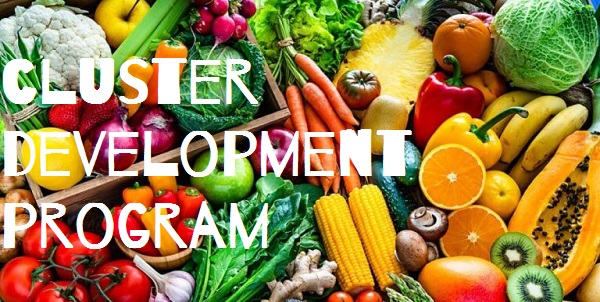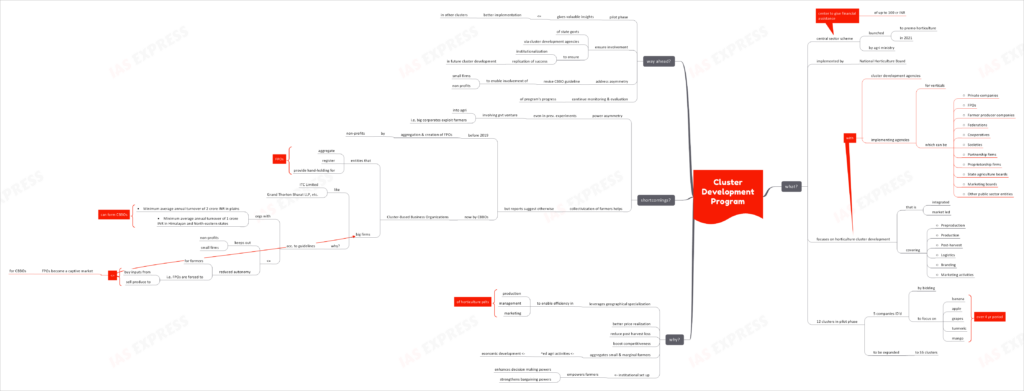Cluster Development Program- The Issue of Power Asymmetry

The central government has identified 5 companies to play the role of implementing agencies in the Cluster Development Program. While the horticulture sector stands to gain much from this initiative, the issue of power asymmetry threatens to counteract the government’s push to empower farmers.

What is the Cluster Development Program?
- The Cluster Development Program is an initiative, launched by the Agriculture Ministry in 2021, to promote horticulture.
- It is a central sector scheme. The central government will be providing financial assistance of up to 100 crore INR, depending on the project size.
- The National Horticulture Board is the nodal agency for implementing this program.
- The program focuses on promoting integrated and market-led development of horticulture clusters, covering:
- Preproduction
- Production
- Post-harvest
- Logistics
- Branding
- Marketing activities.
- Cluster Development Agencies are appointed for the horticulture clusters.
- Apart from this, implementing agencies are appointed for the clusters’ verticals. These agencies can be:
- Private companies
- FPOs
- Farmer producer companies
- Federations
- Cooperatives
- Societies
- Partnership firms
- Proprietorship firms
- State agriculture boards
- Marketing boards
- Other public sector entities
- The program initially selected 12 clusters for pilot launch. 5 companies have been selected as implementing agencies through bidding process. They are to develop clusters for apples, grapes, bananas, turmeric and mango, over a period of 4 years.
- Based on the learnings from these clusters, the program will be scaled up to cover 55 horticulture clusters across the country.
Why was this program launched?
- The program leverages the clusters’ geographical specialization to enable efficiency in production, management and marketing of horticulture products.
- It will enable better price realization for these products.
- It is expected to reduce post-harvest loss.
- It seeks to boost India’s competitiveness in the horticulture sector.
- As it aggregates small and marginal farmers, the program would increase agricultural activities and consequently, facilitate economic development.
- The institutional setup empowers farmers, enhances decision-making capabilities, and strengthens their bargaining power.
What are the shortcomings?
- Power asymmetry has been an issue even in previous experiments involving private ventures into agriculture sector. There have been enough instances of big corporates exploiting farmers through contract farming.
- While collectivization of farmers under the head of FPOs could boost farmers’ bargaining power, recent reports suggest otherwise.
- Before 2019, the role of aggregating and forming FPOs was being performed by local and national non-profits. Nowadays, the same is performed by CBBOs.
- Cluster-Based Business Organizations are entities that aggregate and register FPOs. They provide hand-holding services to these FPOs.
- CBBOs are mainly big firms like ITC Limited, Grand Thorton Bharat LLP, etc. This is because the guidelines mandate that only those organizations can form CBBOs if they have:
- Minimum average annual turnover of 2 crore INR in plains
- Minimum average annual turnover of 1 crore INR in Himalayan and North-eastern states
- This has kept the smaller companies and non-profits out of the loop.
- This has also reduced the farmers’ autonomy. In many cases, the FPOs are forced to buy their inputs and sell their produce only to these big firms.
- This has been transforming FPOs into captive markets for goods produced and sold by CBBOs. This contravenes the objective of empowering farmers.
What is the way ahead?
- The pilot phase of the program provides valuable policy insights and learnings for better implementation in all clusters.
- It is necessary to ensure the involvement of state government bodies through Cluster Development Agencies to ensure institutionalization and replication of successful practices in future cluster development.
- Addressing power asymmetry among stakeholders is crucial for empowering farmers and enhancing their decision-making and bargaining power.
- Guidelines for CBBOs should be revised to include smaller companies and non-profits, promoting a more inclusive and participatory approach.
- The government should continue to monitor and evaluate the program’s progress, ensuring that the benefits reach farmers and contribute to the overall growth of the horticulture sector.
Conclusion:
The cluster development program has the potential to not only boost competitiveness in horticulture sector, but also reform agriculture market in India. However, allowing the power asymmetry to continue would mean that the program would simply enable further exploitation of farmers, counteracting its main objective.
Practice Question for Mains:
What are the advantages and shortcomings of the Horticulture Cluster Development Program? What needs to be done? (250 words)
If you like this post, please share your feedback in the comments section below so that we will upload more posts like this.

